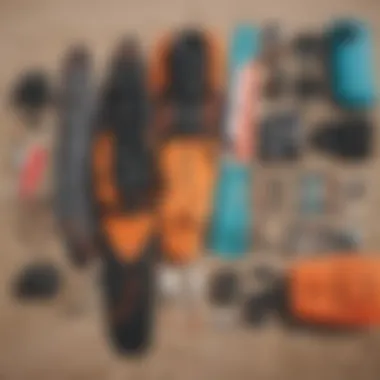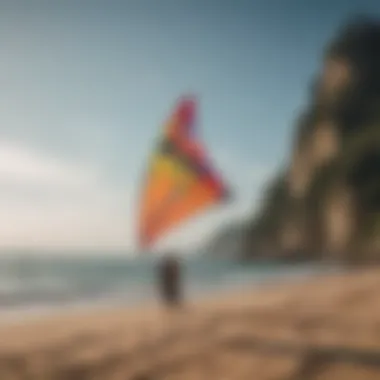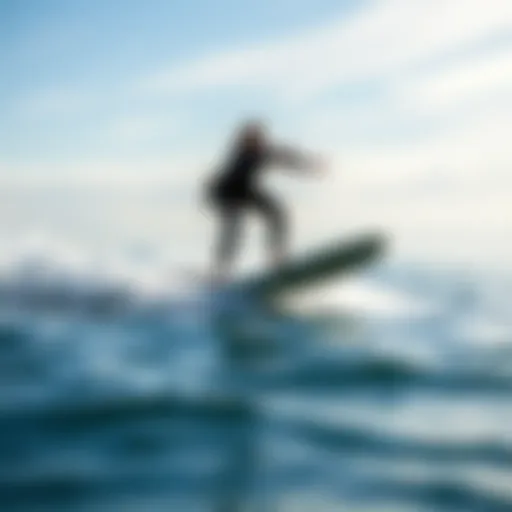Kiteboarding Setup: A Complete Guide for Enthusiasts


Intro
Kiteboarding is more than just a thrilling watersport; it's a dance with the elements, where human ingenuity meets the power of nature. As the sun glints off the waves and the wind fills your kite, the sheer exhilaration of riding can overwhelm even the most seasoned athlete. Yet, before one can harness that joy, understanding the nuances of kiteboarding setup is critical.
This guide brings together a wealth of knowledge tailored for everyone from curious beginners to more experienced practitioners seeking to refine their technique. We tackle each aspect of the setup process, helping you navigate the complexities in a step-by-step manner that promotes clarity and safety.
Nothing spoils a day on the water quicker than improper gear assembly or an inadequate safety check. The journey starts here, as we dive into essential techniques that shape your kiteboarding experience. By deftly mastering these skills, individuals can maximize their time on the waves while minimizing risks associated with this adventurous activity.
Understanding Kiteboarding Gear
Kiteboarding is not just a thrilling sport; it's also a craft that demands the right tools and knowledge to truly master the waves. Having a solid understanding of kiteboarding gear is essential for getting the most out of every session. The gear not only influences performance but also plays a significant role in safety and comfort on the water. Knowing your equipment allows you to maximize your potential and adapt to different conditions.
Kites: Types and Features
When it comes to kites, there’s no one-size-fits-all solution. Each type has its unique features and benefits, catering to specific riding styles or environmental conditions. Here’s a quick breakdown of the main types:
- SLE (Supported Leading Edge) Kites: These are often seen as a happy medium, combining ease of use with performance. Good for beginners, they provide a stable flying experience.
- C Kites: More focused on performance, C kites excel in tricks and high-wind situations. They can be less forgiving for new riders but offer an exhilarating experience for advanced ones.
- Hybrid Kites: Blending the best features of both SLE and C kites, hybrids offer versatility and are popular among a wide range of riders.
Each kite type brings something unique to the table, hence selecting the right one can greatly enhance your kiteboarding experience. Understanding characteristics like shape, aspect ratio, and the materials used can also impact your performance. For instance, kites with a higher aspect ratio generally yield better upwind performance, while those with a lower ratio are easier to handle in gusty conditions.
Boards: Selecting the Right Fit
Just like kites, the right board can make or break your kiteboarding journey. The choices range from twin-tips, which are the most common and forgiving, to directional boards for those interested in surf-style riding.
When selecting a board, consider the following factors:
- Size: Bigger boards provide more floatation, making them ideal for lighter winds. Smaller boards, on the other hand, are better for high-speed performance and tricks.
- Flex: The flexibility of a board affects its responsiveness. Softer boards offer easier landings and are generally smoother in choppy waters, while stiffer boards provide better control at high speeds.
- Fin Configuration: The fins on the board can impact speed and grip. Boards with more fins typically provide better grip, while those with fewer maintain a faster ride.
By carefully choosing the right board, you set the stage for a successful ride, tailored to your skill level and desired style.
Harnesses and Lines: Importance of Proper Gear
A common oversight among new kiteboarders is the significance of harnesses and lines in the overall setup. A proper harness is crucial for comfort and control, connecting you to the kite while allowing for fluid movement. Here are the main types:
- Waist Harness: This is popular among freestyle riders and provides more freedom of movement.
- Seat Harness: Offers better support for beginners and those who prefer more stability.
The choice of harness can depend also on your riding style, so make sure to test a few out.
And let's not forget about the lines! The lines transmit the kite's power, so they must be of high quality and appropriate length. Shorter lines provide a more responsive ride, while longer lines give more power but might feel less connected. It’s essential to check lines for any fraying before each session to avoid risking a mishap on the water.
Pre-Setup Considerations
Before you even think about inflating your kite and hopping on the board, there are some serious pre-setup considerations to keep in mind. These aspects are crucial because they set the stage for a successful ride. Properly assessing conditions, choosing the right venue, and understanding the behavior of tides and currents creates a safer and more enjoyable kiteboarding experience. The right decisions before getting on the water can mean the difference between an exhilarating session and a day best spent at the café.
Assessing Weather Conditions
Kiteboarding is largely weather-dependent, so it’s imperative to put the weather under the microscope before you go. Wind speed, direction, temperature, and barometric pressure are all vital factors. A steady wind between 12 to 25 knots is generally considered optimal for most riders, but this can vary.
- Understand Wind Flags: Look for flags or telltales; they give you a visual cue about wind conditions. If flags are flapping, you likely have a decent breeze. However, watch for gusts; sudden increases can catch inexperienced riders off-guard.
- Pay Attention to Local Forecasts: Local weather apps or sites like Windy.com can give minute-to-minute updates on changing conditions.
- Assess the Air Temperature: If the temperature dips too low, it might lead to hypothermia during a prolonged stay in the water. Consider wearing appropriate gear.
"When the wind starts howlin' and the sky's lookin' shady, it’s a sign to hit pause and rethink your plans."
Choosing the Right Location
All locations are not created equal in kiteboarding. Surfing on flat water compared to riding at a beach with heavy waves makes a huge difference. You want to pick a spot that suits your skill level and riding style.
- Flat Water vs. Wave Riding: Beginners often feel more secure in flat waters. In contrast, experienced riders may seek out tidal zones for challenging wave action.
- Study the Launch Area: A clean and spacious launch area is a must. It ensures you’re not colliding with other kiteboarders, swimmers, or even surfers—safety should be the name of the game.
- Consider Accessibility: Some beaches are easier to access and offer nearby facilities like changing rooms and rentals. Consider convenience and comfort when making your choice.


Understanding Tides and Currents
Tides can be incredibly influential on your kiteboarding experience, especially if you’re on coastal waters. Knowledge of how tides work can prevent unpleasant surprises down the line.
- Know the Tide Schedule: High and low tides can affect wave size and the speed of currents. Many local papers, apps, or even websites like Tide Charts provide this information in advance.
- Recognize the Danger of Strong Currents: Vigorous currents can make getting back to shore difficult, if not impossible. Be mindful of where you are and calculate your ability to navigate back honestly.
- Timing is Everything: The best time to kiteboard is generally during the incoming tide when the current is weaker. This works nicely in many locations where the wind aligns with the tide's push.
Considering these pre-setup elements lays the groundwork for a successful kiteboarding outing. As the old saying goes, "An ounce of prevention is worth a pound of cure," and this rings especially true in the world of adventure sports like kiteboarding.
Step-by-Step Gear Assembly
When it comes to kiteboarding, gear assembly isn't just a routine task—it's a critical foundation for a successful ride. Proper assembly ensures that all components work together seamlessly, reducing the likelihood of mishaps while you're out on the water. From the kite to the board, each piece of gear plays a specific role that directly affects your experience. An oversight in setup can lead to performance issues or, worse, safety hazards. That’s why a methodical approach to this assembly is necessary to boost both safety and enjoyment during your kiteboarding session.
Preparing the Kite
Starting off with the kite itself, preparation is key. Begin by laying out your kite on a flat surface, ensuring it’s free of any debris that may cause damage. Inspect the fabric, seams, and leading edge for any signs of wear. If you find any issues, it’s better to fix them now than take the risk later. Once inspected, inflate the kite partially so you can shape it correctly, helping to avoid any unwanted twists or flapping. This step reinforces the kite’s structure and ensures it performs appropriately once in the air. A well-prepared kite will catch the wind like a charm, enhancing your ride.
Attaching Lines and Safety Features
Lines are the lifelines of your kiteboarding experience. When attaching them, be meticulous. Each line should connect to the corresponding point on the kite without tangles. It might help to structure the lines in a way where color-coding aids your understanding. Not only does this streamline your assembly, but it also minimizes confusion when you’re out in the field.
Equally important are safety features, such as quick release mechanisms and safety leashes. They are your best friends in critical moments. Make sure these features are easy to access and functioning properly. After all, the goal is to ensure a seamless ride. One could say that safety features are to kiteboarding what a seatbelt is to a car—it’s all about keeping you secure when things go south.
Setting Up the Board
The board setup often gets overlooked, but what you don’t realize is that it holds just as much importance. Your kiteboard should be adequately adjusted for your foot size and riding style. Straps need to be fitting but comfortable, allowing a secure grip without causing strain. Take a moment to mount your foot straps, testing if they can be tightened and loosened easily.
Before heading out, check the fins as well. They help you carve through the water, direct your speed, and maintain balance. Missing or damaged fins can significantly impair your riding ability. Ultimately, a properly set up board complements your kite, giving you the edge when you've caught that perfect wave.
"Setting up your kiteboarding gear is not merely a formality; it's a commitment to ensuring a safe, enjoyable experience on the water."
Safety Protocols in Kiteboarding Set Up
Safety protocols in kiteboarding setup are not merely guidelines; they serve as the backbone for ensuring that kiteboarding experiences are both enjoyable and hazard-free. The kite itself can be as powerful as it is exhilarating, and a solid understanding of safety measures is critical. This knowledge not only safeguards the rider but also promotes overall harmony among fellow enthusiasts on the water.
Being vigilant about safety means being prepared for any unexpected mishaps or changes in conditions. Kiteboarding, while straightforward under ideal circumstances, can quickly escalate into risky situations without the right precautions in place. When kiteboarders prioritize safety, they embrace a culture that values awareness, respect, and preparedness—elements that foster greater enjoyment for all.
Pre-Flight Checks
Before a kiteboarder even thinks about hitting the water, undertaking thorough pre-flight checks is essential. This involves a systematic review of all gear, and equipment to ensure everything is functioning properly.
Here’s a brief checklist that can help:
- Inspect the Kite: Check for any punctures or tears. A small hole can lead to catastrophic failure mid-flight.
- Lines State: Examine the lines for fraying or excessive wear. Lines should be smooth and unblemished to ensure safety.
- Harness and Safety Features: Make sure the harness is secure and properly adjusted. Examine your safety release mechanisms to ensure they work effectively.
- Board Attachment: Confirm that your foot straps and any fasteners are correctly situated. Loose foot straps can cause problems when trying to secure your stance.
- Safety Gear: Always wear a helmet, impact vest, or any other protective gear, which can be invaluable should an accident occur.
Taking a few moments to conduct these checks can save a rider from serious injuries and contributes to the overall kiteboarding community’s reputation for safety.
Emergency Procedures
Even when every precaution is taken, accidents can happen. Having a clear plan for emergencies is critical. Riders should familiarize themselves with appropriate procedures tailored to various potential emergencies. Here are some steps to consider:
- Kite Control: If the kite goes out of control, know the maneuvers to depower the kite immediately. Understanding how to use the safety system on your kite is crucial.
- Self-Rescue: Familiarize yourself with self-rescue techniques that involve securing the kite, using it as a flotation device, and making your way back to shore.
- Informing Others: Always let someone on land know your plans. In case of an emergency, they can alert authorities or come to help.
"Preparation breeds confidence. If you’re ready for the worst, you can focus on enjoying the ride."
- Signal for Help: Knowing the proper signals for assistance can also make a difference if you find yourself in a tight spot. Use hand signals or consider carrying a whistle to grab attention.
Staying Aware of Surroundings
Last but certainly not least, situational awareness cannot be overstated. Riders must keep an eye on the conditions around them and be cognizant of both natural elements and other water users. Here’s how to ensure safety through awareness:


- Monitor Weather Changes: Storms can brew quickly without warning. Regularly check the weather while out on the water.
- Watch for Wind Direction: Be cognizant of any sudden changes in wind patterns that could affect kite performance.
- Understand Other Riders’ Movements: Whether it's surfers, swimmers, or fellow kiteboarders, being aware of the proximity of others can prevent collisions and other incidents.
- Know Your Environment: Familiarize yourself with the launch area and keep an eye out for any obstacles, such as rocks or other stationary items that could pose a risk while riding.
In essence, by reinforcing safety protocols, kiteboarders foster a culture of responsibility and enjoyment. Navigating the exhilarating world of kiteboarding requires more than skill; it demands situational awareness, rigorous checking of gear, and preparedness for emergencies. Each of these factors contributes to a thrilling yet secure kiteboarding adventure.
Fine-Tuning Kite Settings
Fine-tuning kite settings is pivotal for optimizing your kiteboarding experience. A small tweak here and there can make a world of difference, helping you harness the wind’s power more effectively while ensuring stability and control. Every kite reacts differently depending on its design and the prevailing conditions, which is why understanding these settings is not just beneficial—it's often essential. Whether you are a beginner or an expert rider, mastering these adjustments can lead to more thrilling rides and, notably, a safer experience.
Wind Adjustment Strategies
Understanding wind dynamics is crucial in kiteboarding. When it comes down to it, your kite's performance is largely dictated by wind direction and strength. Adjusting your kite according to the wind can greatly affect lift and drive.
- Assess Wind Strength: Always start by checking the wind speed. Is it breezy or just a gentle puff? Depending on this, you might switch your kite size. Larger kites catch more wind and are suitable for light conditions, while smaller kites are ideal when the wind is stronger.
- Use the Right Angle: The angle at which the kite is flown can significantly alter your speed and power. A better position allows you to catch more wind. If you’re not moving as fast as you'd like, consider flying the kite higher in the window to decrease drag.
- Adjust the Depower: Many kites come with a depower feature that allows you to reduce the power without changing the angle or position of the kite. Learning to manage depower effectively can help tame an unruly kite, especially in gusty conditions.
"The secret to kiteboarding is learning to dance with the wind—not fight against it."
Changing Trim Settings
Trim settings allow you to alter your kite's attack angle, affecting how it interacts with the wind. Proper trimming assures that your kite operates optimally, leading to enhanced performance on the water. Here’s how to trim your kite effectively:
- Pre-Flight Check: Before heading out, make sure the trim line is set correctly according to the conditions. Ideally, you want to feel comfortable and balanced when the kite is in the air.
- Fine-Tune on the Water: Once on the water, if you sense that you lack control or speed, trim the kite accordingly. If the kite feels sluggish, it might be time to shorten the trim. Conversely, if you encounter excessive pull, lengthening the trim could balance the power.
- Regular Adjustments: Conditions can shift quickly, so be ready to readjust the trim settings as needed. Like adding salt to taste in a dish, it’s crucial to find that perfect balance to stay agile on your board.
Kite Angle of Attack Techniques
The angle at which your kite meets the wind profoundly influences its lift and drag properties. Adjusting this angle is a paramount skill in kiteboarding:
- Lift Generation: Tilting your kite slightly up into the wind can generate more lift, which is particularly useful for jumps. However, tweaking this angle too much can lead to stalling, which is counterproductive.
- Control Through Changes: In varying conditions, you might fancy making more aggressive turns. Lowering your kite significantly during turns allows for quicker directional changes and sharper turns, helping you navigate tight spots.
- Discover Your Preference: Each rider has their unique style. Some prefer a more aggressive angle for immediate lift, while others lean towards a more relaxed position for smooth rides. Experimenting with and fine-tuning your kite's angle of attack will help you discover what works best for you.
Fine-tuning kite settings is not a one-size-fits-all approach. Taking the time to understand how to tweak them can make your rides more exhilarating and keep you riding smoothly over the waves. Opt for a calculated yet intuitive approach to enhance your kiteboarding prowess.
Launching the Kite
Launching the kite is not just one step in kiteboarding; it’s arguably one of the most critical phases that sets the stage for the entire ride. A successful launch means the difference between a positive experience on the water and potential mishaps that could lead to accidents or injuries. Understanding the nuances involved in this process can cultivate a greater appreciation for the sport while ensuring more safety and enjoyment.
When launching the kite, a combination of knowledge and practice comes into play. Timing with wind conditions, selecting the right spot, and effective communication with any partners who are assisting you can significantly affect the outcome. The wind, as fickle as it may seem at times, plays a pivotal role in determining how smoothly the kite will catch air and ascend. Poorly executed launches can lead to loss of control from the very beginning, potentially making a kiteboarder’s day a lot more challenging than it needs to be.
Choosing a Launching Spot
Picking the right launching spot can make all the difference. An ideal location should have ample space around it, allowing free movement without the risk of colliding with people, objects, or, worse, other kiteboarders. Look for a stretch of beach or shoreline that’s free from obstacles like trees or rocks. Ideally, it should also have a consistent wind direction, preferably blowing onshore or across the shore.
- Observe the wind: Take a minute to gauge the direction and strength of the wind. Look for the water's surface – ripples indicate a healthy breeze while flat water suggests the opposite.
- Consider the crowd: Too many people can lead to interference during your launch. It’s prudent to wait for less crowded times if possible.
- Keep safety in mind: Ensure that no one is launching or landing nearby. It’s crucial to avoid confusion and maintain a clear launching area.
Choosing wisely truly lays down the groundwork for an effective launch.
Teamwork and Communication
Kiteboarding is not an isolated sport. Having a partner, even if just for assistance during launch, can enhance safety and effectiveness. Teamwork is the name of the game. Both kiteboarders should communicate clearly about their intentions, especially while launching. A simple gesture can suffice, but verbal cues may be more effective in a bustling environment.
- Assign roles: One person should wrangle the lines while the other prepares to launch. Distinguishing responsibilities can reduce confusion.
- Use hand signals or call out: Ensure both parties are on the same wavelength regarding when to launch the kite. You don’t want someone confusing your signals with a nod to say, 'set, go.'
- Watch each other’s backs: Constantly check around for potential dangers, be it a rogue beachgoer or an approaching wave that could disrupt things.
Overall, teamwork minimizes risk and instills a sense of camaraderie.
Executing the Launch Sequence
Finally, once the spot is secured and communication is established, it’s time to execute the launch sequence. This is where all the preparation culminates into action. The sequence should be executed meticulously, as even a small mistake can lead to accidents. Here's a concise breakdown of that process:
- Secure the lines: Ensure that the lines are untangled and that the knots are clear. Having a clean setup will support a smooth launch.
- Position the kite: Set the kite at a 45-degree angle to the wind. This angle provides stability and enhances the chances of smooth lifting.
- Signal to assistant: Once ready, give a clear signal and communicate if you need help holding the kite in place.
- Release the kite: As you release, keep your body back and allow the kite to lift slowly. Pull firmly on the rear lines to help it fly.
- Be prepared: Many newcomers underestimate the pull of the kite as the wind catches it. Always be ready to regain control swiftly as soon as it ascends.


"A well-executed launch can feel like a dance, where rhythm and timing lead to a perfect ride on the water."
Success comes from combining knowledge of your environment with teamwork and streamlined execution. Following these guidelines can help not just in terms of safety but also can enhance overall enjoyment on the water.
Riding Techniques Post Setup
Mastering the art of riding is pivotal in the world of kiteboarding. The setup may lay the foundation, but the real adventure begins once you hit the water. This segment not only covers skills every rider should hone but also highlights how these techniques can enhance your overall experience. Understanding these riding techniques can empower kiteboarders, bringing finesse and control to each ride.
Effective Edge Control
Edge control is often considered the backbone of kiteboarding. It refers to how well a rider can maneuver the board on the water's surface while adjusting to varying wind conditions. When a rider effectively uses their edges, they can make sharp turns, manage speed, and maintain balance.
- Positioning: Keeping your legs slightly bent and your weight distributed properly is vital. Leaning back and pressing down on your heel edge can also help in maintaining control when the wind starts to pick up.
- Technique: Learning to shift your weight effectively between the heel and toe edges allows you to cut through the water smoothly. Practicing this skill in controlled environments will build confidence over time.
- Feedback from the Kite: Pay attention to how your kite reacts as you edge. A well-tuned kite should feel responsive to your shifts in weight.
Key Benefits:
- Increases speed and control.
- Enhances your ability to ride upwind.
- Minimizes the risk of wipeouts by stabilizing your position.
Managing Speed and Power
Kiteboarding is a dance between harnessing power and moderate speed. Managing speed involves fine-tuning the kite's position and understanding how to work with the wind without getting overpowered. A steady hand and a calm mind can prevent unnecessary tumbles.
- Kite Positioning: Keeping the kite at a lower angle during the ride gives you better control over speed. A High position might feel thrilling but can easily lead to loss of control.
- Throttle Control: Learning to manage your pull is essential. Pulling hard on the bar can quickly lead to acceleration, but being too passive can leave you flat and slow. Finding that middle ground is crucial.
"The best kiteboarders know it’s about pushing and releasing the bar, not just holding on for dear life.”
Considerations:
- Always be conscious of your surroundings; boats or other riders can pose a threat.
- Adjust your kite based on the wind's intensity; in strong winds, learning to trim your lines can mitigate overwhelming power.
Tricks for Advanced Riders
Once a rider has grasped the basics, adding tricks to their repertoire is a thrilling next step. For many kiteboarders, this is where passion meets skill. Tricks not only exhibit a rider's ability but also enhance their enjoyment.
- Jumping: It's a leap of faith! Using speed and power strategically helps lift you off the water. Timing the pop just right when the kite pulls you up makes all the difference.
- Board Offs: This visual stunner involves taking your feet off the board mid-air - a feat of balance and style!
Practice Makes Perfect:
- Start with smaller jumps and gradually work your way up to more advanced maneuvers.
- Record your attempts to analyze your form later; watching yourself can offer unique insights into necessary adjustments.
- Community support from local riders or forums like reddit.com can provide tips and tricks that haven't been covered in traditional lessons.
By mastering effective edge control, managing speed, and trying out tricks, riders can elevate their kiteboarding skills considerably. Practicing these techniques prepares them for various conditions and helps them to react fluidly on the water. Each session brings an opportunity to improve, ensuring that every ride is as exhilarating as the last.
Post-Ride Evaluation and Maintenance
After a day of cutting through the waves and soaring skies, post-ride evaluation and maintenance become essential. Taking the time to inspect your gear not only prolongs its life but also helps ensure your next outing is as enjoyable as the last one. The salty wind and spray are exhilarating, but the wear and tear on your equipment can be sneaky. Thus, establishing a routine after each session is vital for kiteboarders.
Cleaning and Storing Gear
The importance of cleaning your gear cannot be overstated. Saltwater and sand can quickly become your gear's worst enemy. Once you've returned to shore, it's wise to rinse your kite, board, and lines with fresh water. Here’s a quick rundown:
- Kite: Shake off any sand and rinse it thoroughly. Pay special attention to the leading edge and seams, as they tend to gather debris.
- Board: A simple wash with mild soap will work wonders. Be sure to clean off the foot pads and fins as they can trap sand and salt.
- Lines: Swish them around in fresh water to get rid of salt crystals and sand particles. A clean line is a happy line, reducing the risk of tangles and tears.
After cleaning, ensure everything is completely dry before stowing it away. Storing damp gear can lead to mold—nobody wants that on their favorite kite! It’s highly recommended to roll the kite instead of folding it. This prevents creases, which can weaken the fabric and alter its performance.
"An ounce of prevention is worth a pound of cure." - Benjamin Franklin
Identifying Wear and Tear
Taking the time to thoroughly inspect your equipment after each session can save you a heap of trouble in the long run. Look for any signs of wear and tear:
- Kite: Check for rips, punctures, or fading. Pay close attention to the bridles and understand that even a small tear can impact performance significantly.
- Board: Inspect for scratches, delamination, or cracks. A damaged board can throw off your balance and affect your ride.
- Lines: Look for fraying or nicks; they can compromise the lines' integrity, putting you at risk during use.
Performing a visual and tactile inspection after each ride adds to your safety and assures that your gear remains in peak working condition. Noticing these issues early means you can address them right away, ensuring that your next kiteboarding adventure will be both thrilling and trouble-free.
In summary, post-ride evaluation is no mere afterthought. It’s an integral part of kiteboarding that underscores the care and respect we owe to our gear. By routinely cleaning and vigilantly checking for wear, you not only enhance your performance but also extend the life of your favorite kiteboarding equipment.







